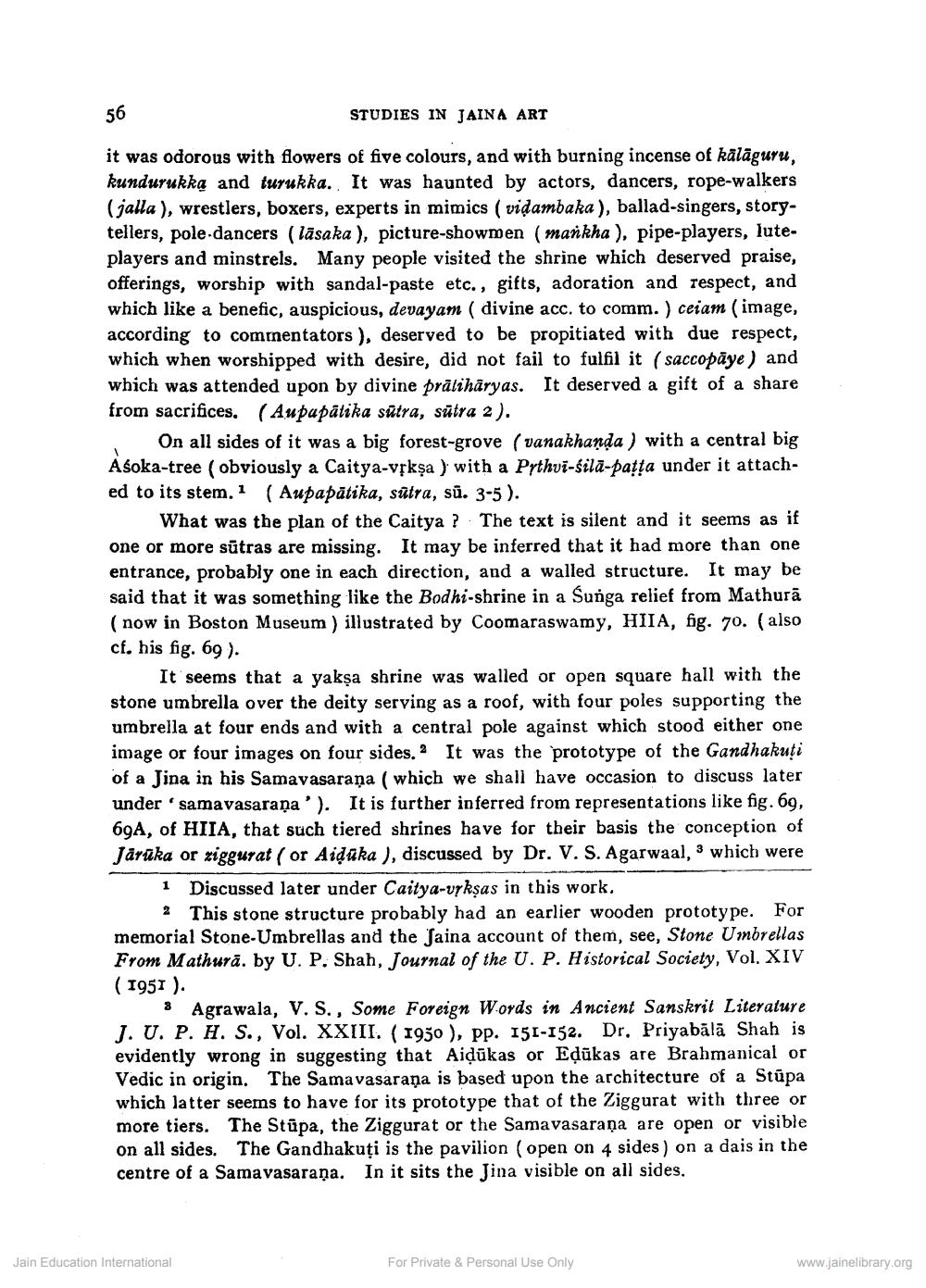________________
56
STUDIES IN JAINA ART
it was odorous with flowers of five colours, and with burning incense of kālāguru, kundurukką and turukka. It was haunted by actors, dancers, rope-walkers (jalla), wrestlers, boxers, experts in mimics (vidambaka), ballad-singers, storytellers, pole dancers (lāsaka ), picture-showmen (mankha), pipe-players, luteplayers and minstrels. Many people visited the shrine which deserved praise, offerings, worship with sandal-paste etc., gifts, adoration and respect, and which like a benefic, auspicious, devayam ( divine acc. to comm.) ceiam (image, according to commentators ), deserved to be propitiated with due respect, which when worshipped with desire, did not fail to fulfil it (saccopāye ) and which was attended upon by divine prālihāryas. It deserved a gift of a share from sacrifices. (Aupapātika sūtra, sūtra 2).
On all sides of it was a big forest-grove (vanakhanda) with a central big Asoka-tree (obviously a Caitya-vşkşa ) with a Pythvi-sila-patta under it attached to its stem.1 ( Aupapātika, sütra, sū. 3-5).
What was the plan of the Caitya ? The text is silent and it seems as if one or more sūtras are missing. It may be inferred that it had more than one entrance, probably one in each direction, and a walled structure. It may be said that it was something like the Bodhi-shrine in a Sunga relief from Mathurā (now in Boston Museum ) illustrated by Coomaraswamy, HIIA, fig. 70. (also cf, his fig. 69).
It seems that a yakşa shrine was walled or open square hall with the stone umbrella over the deity serving as a roof, with four poles supporting the umbrella at four ends and with a central pole against which stood either one image or four images on four sides. It was the prototype of the Gandhakuți of a Jina in his Samavasarana ( which we shall have occasion to discuss later under samavasaraņa"). It is further inferred from representations like fig. 69, 69A, of HIIA, that such tiered shrines have for their basis the conception of Jarūka or ziggurator Aidaka ), discussed by Dr. V. S. Agarwaal, which were
1 Discussed later under Caitya-vykşas in this work.
2 This stone structure probably had an earlier wooden prototype. For memorial Stone-Umbrellas and the Jaina account of them, see, Stone Umbrellas From Mathurā. by U. P. Shah, Journal of the U. P. Historical Society, Vol. XIV (1951).
8 Agrawala, V.S., Some Foreign Words in Ancient Sanskrit Literature J. U. P. H. S., Vol. XXIII. (1950), pp. 151-152. Dr. Priyabālā Shah is evidently wrong in suggesting that Aidūkas or Edūkas are Brahmanical or Vedic in origin. The Samavasaraña is based upon the architecture of a Stūpa which latter seems to have for its prototype that of the Ziggurat with three or more tiers. The Stūpa, the Ziggurat or the Samavasaraņa are open or visible on all sides. The Gandhakuţi is the pavilion (open on 4 sides) on a dais in the centre of a Samavasaraņa. In it sits the Jina visible on all sides.
Jain Education International
For Private & Personal Use Only
www.jainelibrary.org




